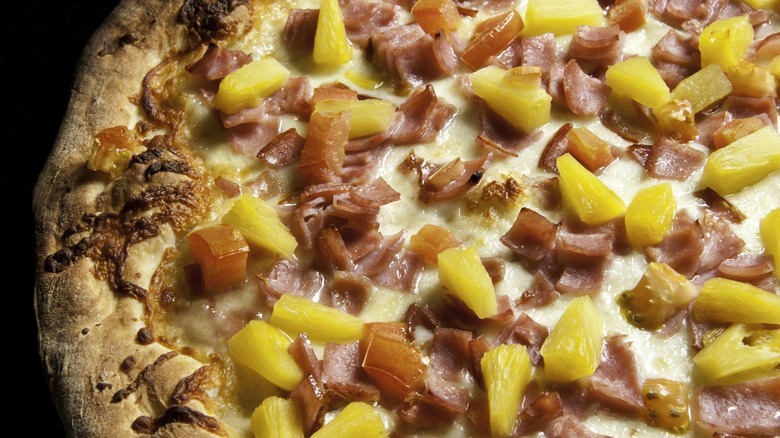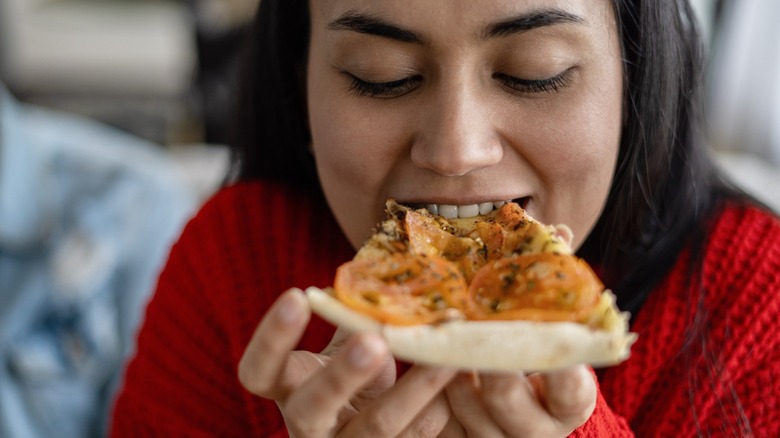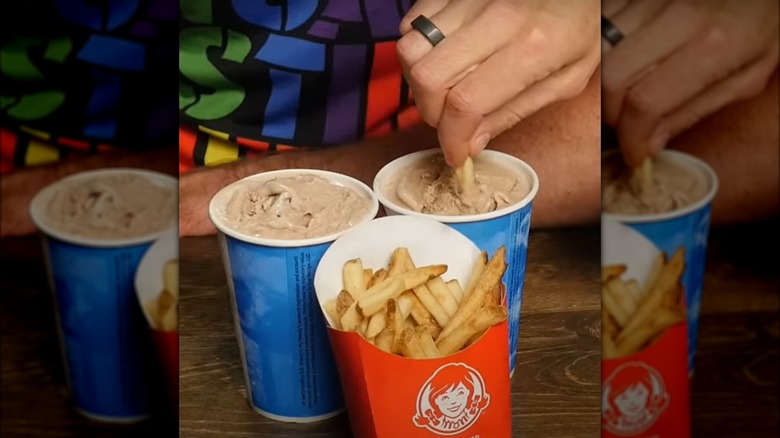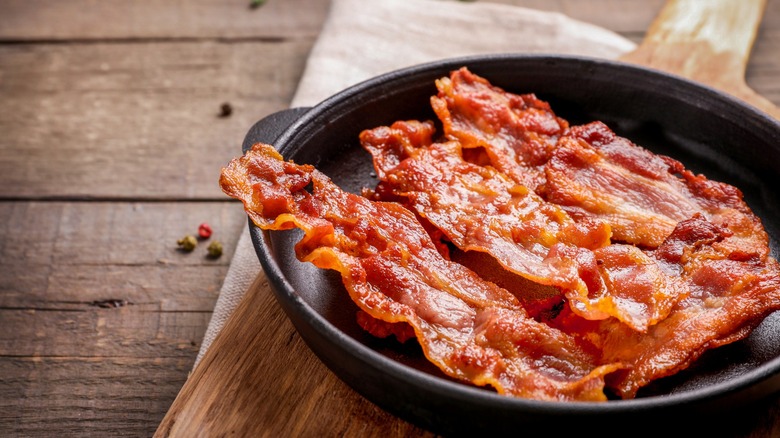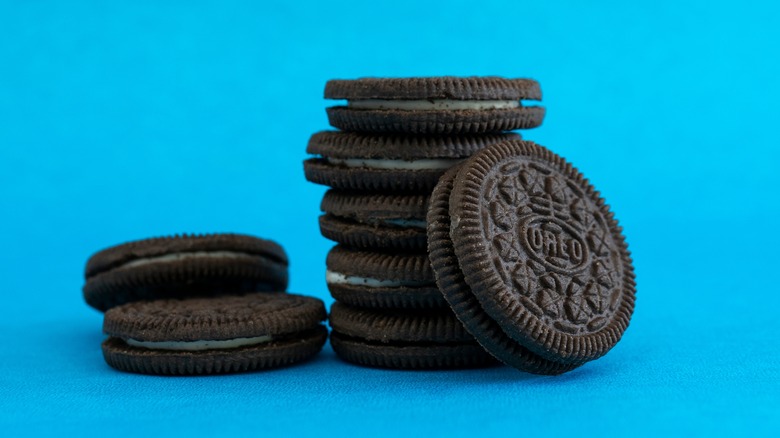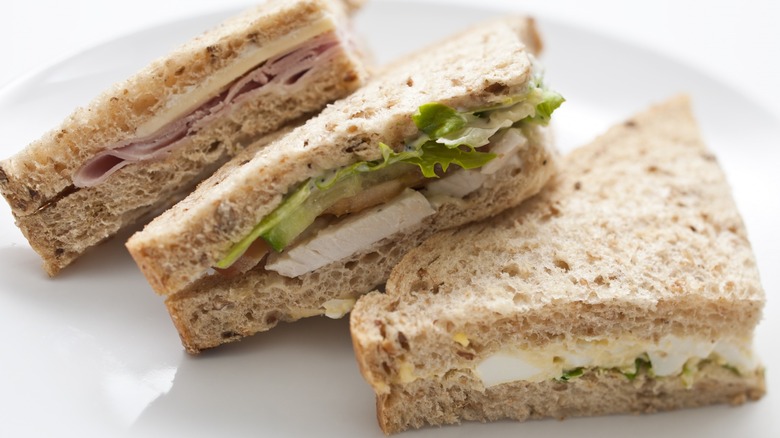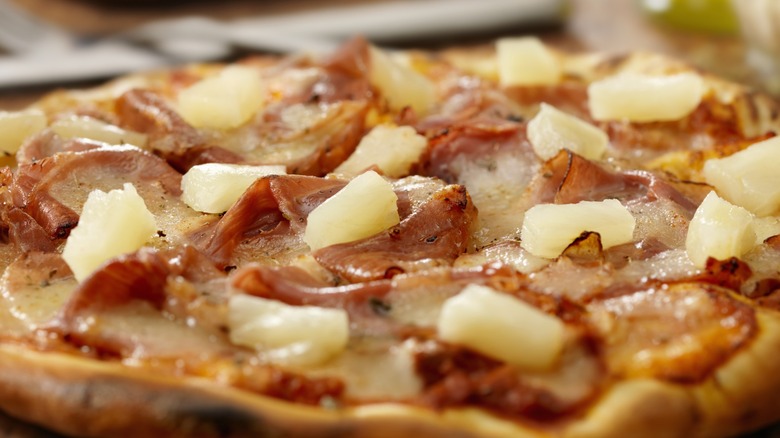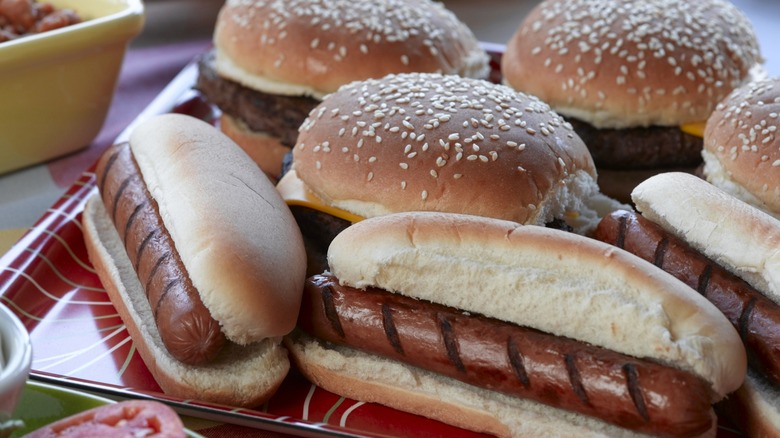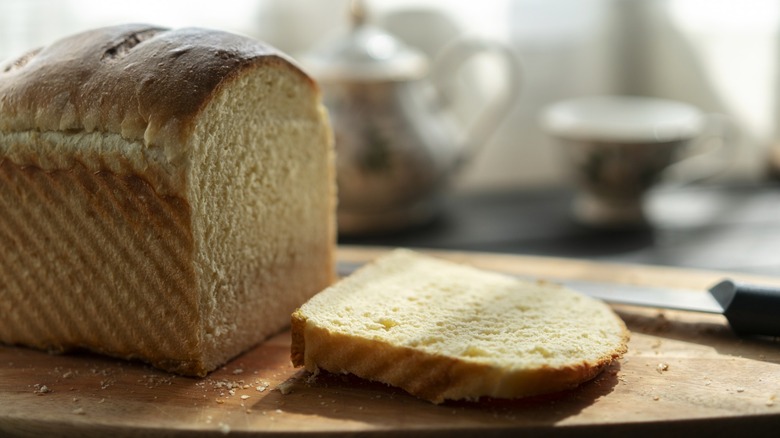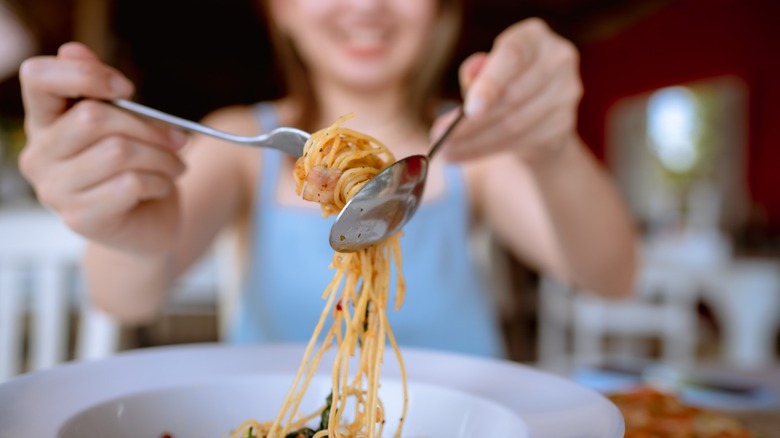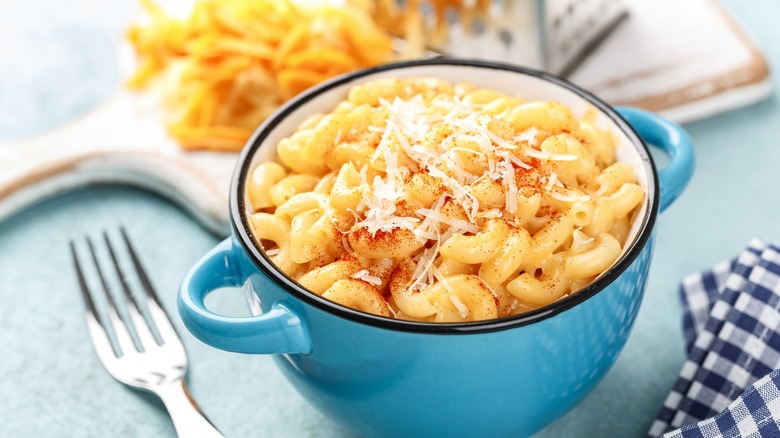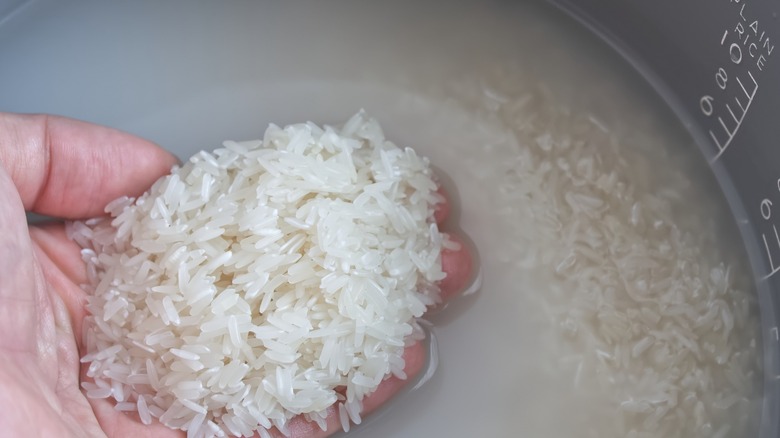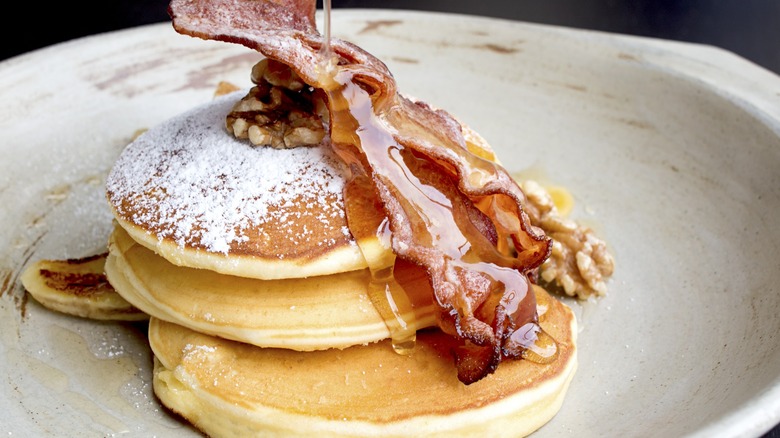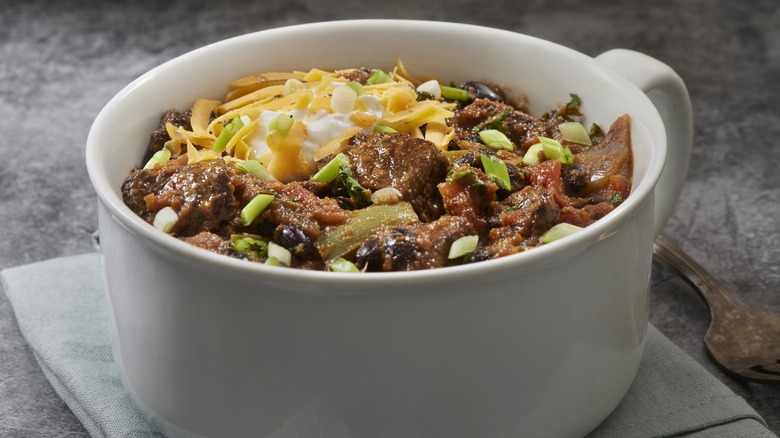15 Controversial Food Debates Of Our Generation
Food. It's what we're all here to read about, and it turns out most of us really care about our food — how it's made, how it's served, and how it's eaten. Our strong opinions on food have given rise to some pretty interesting and controversial debates over the years, from how you should eat Oreos to whether or not dipping your fries in a milkshake is a huge no-no.
Though there are far too many food debates out there for us to provide you with a definitive list, we've rounded up some of the most controversial. You, your friends, and your family are sure to have your own opinions on these, so prepare your notes and your arguments and get ready for a heated debate on whether or not you should fold pizza when eating it, and if it's okay to squeeze ketchup on top of your fries (or if it belongs on the side).
1. Should you fold pizza when eating it?
Are you one of those people who folds pizza to eat it? Or perhaps your friends do, and you're always asking them why? Some people prefer to just hold their slice by the crust. There are even those who — heaven forbid — use a knife and fork to eat their pizza. Yes, really! You might even be one of those people, and hey, we're not judging you.
Italian chef Stefano Cirene, owner of Verace Pizzeria in New South Wales, Australia, tells the Deccan Chronicle that those who fold their pizza are on the right track. He recommends folding your slice into a wallet shape, as they used to do in Naples — that means folding it once, then again, then eating it. This stops any of the toppings from falling off, too! New Yorkers are known for folding their pizza, too — it's not a must, but NYC-style pizza's thin crust makes it easier to eat when it's folded.
Did you know that there could be more to the way you eat your pizza than just personal preference, though? According to body language experts, the way you choose to eat your pizza reveals your personality. Eating the crust first supposedly means you're spontaneous. If you fold your slice, you could be impatient and/or a multitasker, trying to do other things at the same time, like read a book or phone a friend. Don't take this too seriously, as it's just a bit of fun — but then again, it might be accurate.
2. Should you dip your fries in your milkshake?
Salty, crunchy fries dipped in a thick, creamy milkshake? It's a love-hate scenario for most of us, but it's something that seems to have become more common in recent years. Or perhaps people always did it, but it's just more visible on social media these days — who's to say?
Whatever your views on dipping fries in a milkshake, it remains a thing that's not going anywhere fast. Maybe the same people who love the sweet-savory combo of bacon and maple syrup go all-in for fries dipped in a shake? It's definitely a divisive subject, and one that many of us are on the fence on. There's actually a scientific reason why fries in a shake might taste good to you, though — salt can actually enhance the effect of sugar on our taste buds.
Sweet and salty is a popular flavor choice, but fries and shakes might be a step too far. Then again, maybe it depends on where the fries and shake are from, how crispy and salty the fries are, or what flavor of milkshake you're dipping them in.
3. How crispy should bacon be?
Bacon: the food of the gods! But do you like yours floppy and chewy, lightly caramelized and golden brown, or so crispy it shatters when you bite into it? While there's no right or wrong way to enjoy bacon — let's face it, the stuff tastes amazing no matter what you do to it — everybody definitely has their own personal preference, and it's more likely a textural thing rather than a flavor thing.
That said, some people say soft bacon has more of a smoky flavor and that cooking the bacon gently allows that flavor to shine through and be appreciated. Others like the deeply charred, super crispy crunch that you get from well-done bacon. Perhaps the great bacon-cooking divide is a country-specific thing? In the U.S., we most often see bacon depicted in the media as thin, crispy rashers. True, not everybody likes it that way, but the majority of us wouldn't turn down the crispy stuff.
It could be down to the type of bacon, too. In the U.S., rashers of streaky bacon, marbled with fat, are the norm. Back bacon is more common in the U.K. and Europe — though the streaky stuff is still available in most stores. When streaky bacon cooks, the fat renders and becomes deliciously crispy. That happens less with back bacon, as there's less fat to crisp up. At the end of the day, how you enjoy your bacon doesn't really matter — it's tasty however it's cooked.
4. Should you split Oreos in half or eat them whole?
We're prepared to open a whole can of worms on this debate: Should you split Oreos in half or eat them whole? This choice feels like it's been around since the dawn of time — well, since the dawn of the Oreo in 1912, anyway. Each chocolate-flavored cookie has two parts, sandwiched together with a creamy filling. So how do you eat yours?
Are you one of those people who splits their Oreo cookie open — carefully — and scrapes off the filling with their teeth before eating each half of the cookie? Or do you just dive in with a bite of the whole cookie? People take this decision pretty seriously. In fact, even splitting the cookies in half is more complicated than it seems, as MIT researchers proved when they wrote a research paper about how to ensure a perfect split of cookie creme on each half.
There's no right or wrong way to eat your Oreos, so ultimately you should do whichever makes your heart happy. Just be prepared for some strange looks from your other half if you're on separate sides of the fence on this debate.
5. Do you slice a sandwich horizontally or diagonally?
The humble sandwich has a pretty rich history dating back to the 18th century, when it was supposedly invented by the 4th Earl of Sandwich. Since then, we may have upgraded our sandwich fillings to suit modern tastes, but one thing hasn't changed: the debate over how to cut your sandwiches.
Cutting sandwiches diagonally is popular for special occasions where finger foods are served, as this looks daintier. Some people say cutting your sandwich diagonally gives the illusion that it's bigger and more evenly distributes the filling. Some say it's just easier on the eye. However, your personal preference may ultimately come down to how your mom (or dad) cut your PB&J as a kid.
Or perhaps it comes down to math. The surface area of bread without crust changes depending on how you cut your sandwich. Take a square slice of bread that's 4 inches by 4 inches. That's 16 inches of crust. If you cut the bread diagonally, you'll enjoy almost 11 inches of bread without crust. Compare that to slicing the bread down the middle, which only gives you 8 inches of crustless bread. Could that explain why some people like triangular sandwiches more than rectangular ones?
Whether you choose to cut your sandwiches horizontally or diagonally really comes down to personal preference. The flavor's still the same no matter how you cut them!
6. Does pineapple belong on pizza?
You're either team pineapple on pizza or you're not — not everyone agrees that the combo of sweet and salty works on a pizza, and that's okay — having our own favorite pizza toppings keeps life interesting. Some people take their hatred of pineapple on pizza too far, though.
In 2017, Guðni Th. Jóhannesson, then president of Iceland, made international news when he said he wanted to ban pineapple as a topping on pizza. Even if you don't enjoy sweet, juicy chunks of pineapple on your pizza, that seems a little of an overreaction to us. Just don't order a Hawaiian!
The jury seems to be out on whether pineapple belongs on pizza or not, as a survey by YouGov in the U.K. revealed. While 53% of people who responded said they liked pineapple on pizza, 41% most definitely didn't want to find any of the bright yellow fruit lurking on their pie.
7. Are burgers and hot dogs sandwiches?
There's nothing quite like firing up the grill on a sunny day and cooking up hearty burgers and hot dogs for the family. But while these foods have become American summertime staples, there's still a fierce and controversial debate raging: Are burgers and hot dogs sandwiches? Technically, yes.
According to Merriam-Webster, sandwiches are defined as "two or more slices of bread or a split roll having a filling in between." That sounds pretty much like a hot dog or burger to us. So they're sandwiches by definition, yet the debate continues.
In the past, the Daily Meal team voiced the decision that a burger is a sandwich, yet a hot dog is ... a hot dog. That's because the bun is on the side of the sausage, rather than the horizontal setup for most burgers and sandwiches. Again, this is a pretty loose debate, and everyone will have their own opinion — but now you know ours!
8. Does ketchup belong on top of fries, or should it go on the side?
Are you a squirter or a dipper? We mean when it comes to ketchup, of course, and the classic combo of fries with ketchup. Do you squeeze your ketchup all over your fries, or enjoy it in a dainty little pot on the side for dipping?
One Yelp user puts it best: "Squirting ketchup over the fries is so 80's. It used to be rad." You might agree, but then again, it all comes down to a matter of personal preference. Does it depend on the type of fries, too? Squirting ketchup liberally all over chunky fries — or chips, if you're in the U.K. — is a good move, but if you're eating skinny fries, it could make them soggy.
Whether you're a dipper or a squirter, one thing is for sure: Ketchup and fries belong together. Nobody will judge you if you like your ketchup and fries a little retro!
9. What's the end slice of a loaf of bread called?
The heel, the butt, the knob, the crust, the outside, the ender ... it turns out there are loads more weird names for the end slice of a loaf of bread than you could ever imagine. We're not sure where they all come from, either. However, there's one term that stands out above the others.
According to a Reddit survey, almost 40% of people call the end slice of a loaf of bread some variation of the heel. That's what many of us would call it, and we're willing to bet plenty of our readers know it as that, too. The crust is also a pretty common descriptor as well. There's no right or wrong word for it, though, and it varies depending on where in the world you are and what terminology your family used growing up. One respondent from the U.S. referred to the heel as the "Tasty Boy," which is certainly unique.
10. Should you twirl your spaghetti or cut it up?
In Italy, children are taught to twirl long strands of spaghetti at a young age, so if you're visiting Italy, you should really try to follow the country's customs when eating spaghetti. That means twirling your pasta around your fork — in Italy, locals never use a spoon to twirl it against.
For much of the adult population of the U.S. and Europe, twirling is the only polite way to eat spaghetti. True, it's probably still going to splash sauce on your face and over what you're wearing — which is why wearing white is never recommended — but it's better than the alternative. Cutting up spaghetti is really only acceptable if you're a kid or somebody who struggles with eating it whole. By all means, if that's you, then cut your pasta up and enjoy it; but try to avoid doing it in Italy.
11. Do you eat mac and cheese with a spoon or fork?
Do you eat your mac and cheese with a spoon or a fork? It really comes down to personal choice. Do you prefer to stab each piece of macaroni with a fork or spoon up every last drop of that deliciously creamy, cheesy sauce? It might depend on the consistency of your homemade mac and cheese, too — some people prefer theirs drier and crispier, while others make a saucier version.
According to a 2023 survey by Kraft Dinner (KD) in Canada, of the 80% of Canadians that eat KD, nearly half of them — 43% — eat it with a spoon. A survey in 2018 by Annies also revealed whether people prefer to eat mac and cheese with a fork or spoon. According to the results, 71% of adults prefer using a fork to eat their mac and cheese, while only 28% would choose a spoon as their preference. Most parents also said they gave their kids a spoon to enjoy mac and cheese — it's just less messy that way.
12. Should you wash your rice before cooking it (and do you add salt)?
Watch any Asian cookery video on YouTube, and one thing you'll always see is the chef washing their rice. It's commonplace for almost everyone in Asia to wash their rice, though it's not quite as common across much of the rest of the world. Washing rice removes the excess starch that could cause it to clump together, so for light, fluffy grains, rinsing it until the water runs clear is essential.
There's also the safety aspect: The FDA recommends rinsing your rice to remove the inorganic arsenic content that's naturally present. There may be other contaminants such as dirt in rice, too, depending on where you purchase it from, so rinsing it is a good idea.
Rinsing or washing rice isn't as essential for short-grain rice, such as the type used in paella, as this dish requires the starch in the rice for texture and that layer of crispy flavor that develops as everything is cooking together in the pan. It's also not necessary if you're making sticky rice, as you want the rice to clump together. Adding salt is also a bit of a divisive topic — using some kind of meat stock to cook rice seems more commonplace than adding salt.
13. Does maple syrup belong with bacon?
If you're reading this debate and thinking, "Mmm, yes," you're not alone. Maple syrup and bacon are a match made in heaven, and there's nothing quite like crispy bacon on top of a stack of pancakes, liberally drizzled with maple syrup. You could even go one step further and buy bacon cooked in a maple glaze. But this classic food combo has actually given rise to a pretty polarizing debate.
For lovers of sweet and salty combos, bacon and maple syrup is a no-brainer. There's something about the robust sweetness of the syrup that pairs perfectly with the crisp, salty crunch of the bacon for mouthwatering results. Some people prefer sausage to bacon, for the same sweet and salty hit. Then, there are those who don't do sweet and salty and believe that maple syrup belongs only on dishes like pancakes and waffles. You do you, though.
14. Can you eat cereal for dinner?
The correct answer to this is, of course, that you can eat whatever you like for dinner! Well, provided you live alone and don't have a family to cook for — though they might want cereal, too. It's true that muesli, oatmeal, and cornflakes are usually consumed for breakfast, but that doesn't stop many of us from enjoying cereal for lunch or even dinner.
Cereal is relatively healthy, provided you don't choose one that's packed with added sugar, and makes for a great speedy lunch or dinner on those days when you simply don't have time to cook or prepare anything else. It's also a lighter option than a full meal, provided you don't have it too often. Nutritionists advise against consuming sugary cereal late at night, though, as it can spike your blood sugar, so you'll wake up feeling hungry. In conclusion, you can have cereal for dinner; just don't eat it every night!
15. Should chili have beans (and what goes on the side)?
A classic pot of chili is something to be treasured. There's nothing quite as hearty or delicious — but wait. Do you make your chili with beans? This is a debate as old as time, and it turns out that your opinion on whether or not beans belong in chili could be dependent on the region you live in, as well as how your family made chili when you were growing up.
Texans take their chili seriously, and rightfully so. Classic Texan chili never has beans, while in other parts of the U.S., it can vary. What you eat on the side of your chili varies regionally, too. Cornbread is a popular choice. Some people prefer a stack of saltines. Then, there are the cinnamon roll lovers. Say what? Yup — in some parts of the U.S., it's not unheard of to find a sweet, sticky cinnamon roll on the side of a bowl of chili. This seems to be mostly an Iowa thing, and it may have its roots in school lunchrooms. A legendary local lunch lady popularized the pairing in the '40s, and it's been served to Iowan kids ever since!
To bean, or not to bean? That, indeed, is the question. The answer remains murky and probably comes down to (a) what flavor profile you prefer in your chili, and (b) whether you truly care what anyone else thinks — just don't feed your friends from Texas chili with beans!
16. Do you pour cereal or milk first?
Cereal and milk first joined forces in 1863, and ever since, people have asked themselves, "Do I pour the milk or the cereal first?" You've probably experimented with both methods and discovered your preferred strategy. But if we're being honest, each has its pros and cons.
The Reddit community has debated this very topic, with one user defending the cereal-first approach: "Cereal first gives you portion control and a milk level indicator." Meanwhile, others preferred pouring milk first because it gave them more control over the cereal's crunchiness. If that sounds like you, pour slowly so the cereal doesn't get too soggy, and be cautious of some inevitable splashing along the way.
On the same thread, another user completely broke with convention by commenting, "I do neither. I put cereal in the bowl, get a glass of milk, and then eat them. Take a bite and then a sip." That's one way to keep the milk and cereal flavors pure. However, they make such a dynamic duo because they taste great together — and there's something undeniably nostalgic about a bowl of cereal with milk. So don't let the naysayers bring you down. Stand by your cereal strategy because ultimately, it comes down to individual priorities.
17. Coke or Pepsi?
Coke or Pepsi? If you knew your answer immediately, you're not alone. The majority of people have strong opinions on the matter. After all, the Cola Wars have raged on for decades, and it's still a hotly debated topic today. But is it all just marketing hype? We think not because Coke and Pepsi have distinct flavors. Coke has a smoother taste and more carbonation, while Pepsi has a sweeter kick.
That being said, we can't deny that people are often biased based on familiarity or emotional attachment. Did you grow up drinking one or the other? Maybe your loyalty lies with Coke since it's the O.G. of the cola world. Or perhaps you like being a little retro by reaching for Pepsi instead. Whatever your preference, your perception of the brands likely plays a role. According to World Metrics, a blind taste test between Pepsi and Coke showed that people were split right down the middle. However, the site also reports that more people recognize Coca-Cola's logo than Pepsi's, and Coca-Cola has a stronger following on Facebook.
So, can you honestly say which one you prefer? And is your answer based on taste or soda pop politics? The only way to truly know where you stand is to try the Pepsi Challenge yourself.
